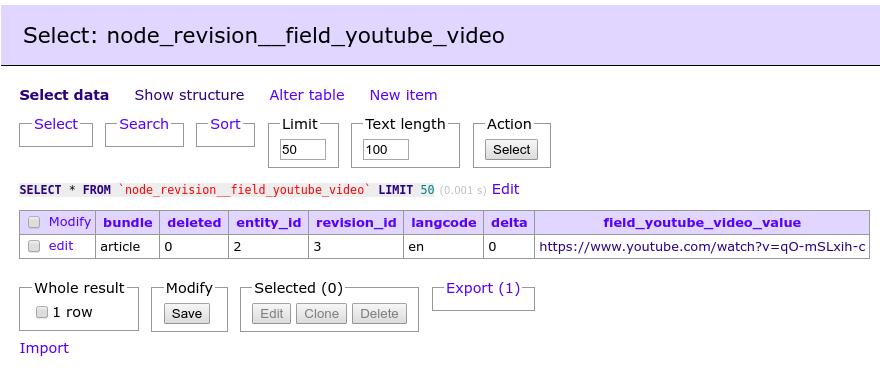9.10.3. 在 Drupal 中处理字段。创建自定义字段类型、小部件和格式化器,用于插入来自 YouTube 的视频。
在之前的文章中,我们已经了解了链接字段类型(Link field type)的工作方式:存储(Storage)、小部件(Widget)、格式化器(Formatter)。在本篇文章中,我们将创建一个自定义的字段类型,用于在页面上输出来自 YouTube 的视频,并提供两种不同的显示格式和设置。
本文重点介绍 Fields API。如果你只是想为你的网站添加一个 YouTube 视频字段,那么更好的选择是直接使用现成的模块:
https://www.drupal.org/project/video_embed_field
我已经将所有代码上传到了 GitHub 中的 drupalbook_youtube 模块中,你可以下载该模块并将其添加到你的站点:
https://github.com/levmyshkin/drupalbook8
我们来看一下该模块的文件结构,并尝试解释这种字段类型是如何工作的:
modules/custom/drupalbook_youtube/drupalbook_youtube.info.yml
name: DrupalBook Youtube
type: module
description: Youtube embed field
core: 8.x
package: Custom定义模块的元数据。
modules/custom/drupalbook_youtube/src/Plugin/Field/FieldType/DrupalbookYoutubeItem.php
<?php
namespace Drupal\drupalbook_youtube\Plugin\Field\FieldType;
use Drupal\Core\Field\FieldItemBase;
use Drupal\Core\Field\FieldStorageDefinitionInterface;
use Drupal\Core\TypedData\DataDefinition;
/**
* Plugin implementation of the 'drupalbook_youtube' field type.
*
* @FieldType(
* id = "drupalbook_youtube",
* label = @Translation("Embed Youtube video"),
* module = "drupalbook_youtube",
* description = @Translation("Output video from Youtube."),
* default_widget = "drupalbook_youtube",
* default_formatter = "drupalbook_youtube_thumbnail"
* )
*/
class DrupalbookYoutubeItem extends FieldItemBase {
/**
* {@inheritdoc}
*/
public static function schema(FieldStorageDefinitionInterface $field_definition) {
return array(
'columns' => array(
'value' => array(
'type' => 'text',
'size' => 'tiny',
'not null' => FALSE,
),
),
);
}
/**
* {@inheritdoc}
*/
public function isEmpty() {
$value = $this->get('value')->getValue();
return $value === NULL || $value === '';
}
/**
* {@inheritdoc}
*/
public static function propertyDefinitions(FieldStorageDefinitionInterface $field_definition) {
$properties['value'] = DataDefinition::create('string')
->setLabel(t('Youtube video URL'));
return $properties;
}
}创建字段类型,使 Drupal 知道我们将在该字段的数据库表中存储什么内容。
<?php
namespace Drupal\drupalbook_youtube\Plugin\Field\FieldType;
use Drupal\Core\Field\FieldItemBase;
use Drupal\Core\Field\FieldStorageDefinitionInterface;
use Drupal\Core\TypedData\DataDefinition;
定义我们字段类型的命名空间。
为我们的类编写抽象描述,Drupal 将根据此注释获取字段类型名称和机器名称。
class DrupalbookYoutubeItem extends FieldItemBase {
类名最好以 Item 结尾。
/**
* {@inheritdoc}
*/
public static function schema(FieldStorageDefinitionInterface $field_definition) {
return array(
'columns' => array(
'value' => array(
'type' => 'text',
'size' => 'tiny',
'not null' => FALSE,
),
),
);
}定义我们将在数据库中存储的列类型(text)。
/**
* {@inheritdoc}
*/
public function isEmpty() {
$value = $this->get('value')->getValue();
return $value === NULL || $value === '';
}当从第三方代码调用该字段时,如果字段为空,则返回一个空结果作为回退。
/**
* {@inheritdoc}
*/
public static function propertyDefinitions(FieldStorageDefinitionInterface $field_definition) {
$properties['value'] = DataDefinition::create('string')
->setLabel(t('Youtube video URL'));
return $properties;
}描述 MySQL 表的列和实体对象。最终我们会存储整个链接:

现在我们已经添加了字段类型,接下来创建一个 Widget 用于数据输入:
modules/custom/drupalbook_youtube/src/Plugin/Field/FieldWidget/DrupalbookYoutubeWidget.php
<?php
namespace Drupal\drupalbook_youtube\Plugin\Field\FieldWidget;
use Drupal\Core\Field\FieldItemListInterface;
use Drupal\Core\Field\WidgetBase;
use Drupal\Core\Form\FormStateInterface;
/**
* Plugin implementation of the 'drupalbook_youtube' widget.
*
* @FieldWidget(
* id = "drupalbook_youtube",
* module = "drupalbook_youtube",
* label = @Translation("Youtube video URL"),
* field_types = {
* "drupalbook_youtube"
* }
* )
*/
class DrupalbookYoutubeWidget extends WidgetBase {
/**
* {@inheritdoc}
*/
public function formElement(FieldItemListInterface $items, $delta, array $element, array &$form, FormStateInterface $form_state) {
$value = isset($items[$delta]->value) ? $items[$delta]->value : '';
$element += array(
'#type' => 'textfield',
'#default_value' => $value,
'#size' => 32,
'#maxlength' => 256,
'#element_validate' => array(
array($this, 'validate'),
),
);
return array('value' => $element);
}
/**
* Validate the color text field.
*/
public function validate($element, FormStateInterface $form_state) {
$value = $element['#value'];
if (strlen($value) == 0) {
$form_state->setValueForElement($element, '');
return;
}
if(!preg_match("#(?<=v=)[a-zA-Z0-9-]+(?=&)|(?<=v\/)[^&\n]+(?=\?)|(?<=v=)[^&\n]+|(?<=youtu.be/)[^&\n]+#", $value, $matches)) {
$form_state->setError($element, t("Youtube video URL is not correct."));
}
}
}该 Widget 将允许我们在实体编辑表单中输入数据。
/**
* Plugin implementation of the 'drupalbook_youtube' widget.
*
* @FieldWidget(
* id = "drupalbook_youtube",
* module = "drupalbook_youtube",
* label = @Translation("Youtube video URL"),
* field_types = {
* "drupalbook_youtube"
* }
* )
*/在类注解中,我们必须指定上面创建的字段类型(drupalbook_youtube)。
class DrupalbookYoutubeWidget extends WidgetBase {类名以 Widget 结尾,表示该类用于字段小部件(Field Widget)。
/**
* {@inheritdoc}
*/
public function formElement(FieldItemListInterface $items, $delta, array $element, array &$form, FormStateInterface $form_state) {
$value = isset($items[$delta]->value) ? $items[$delta]->value : '';
$element += array(
'#type' => 'textfield',
'#default_value' => $value,
'#size' => 32,
'#maxlength' => 256,
'#element_validate' => array(
array($this, 'validate'),
),
);
return array('value' => $element);
}通过 Form API 创建一个简单的文本字段,用于输入 YouTube 视频链接。
/**
* Validate the color text field.
*/
public function validate($element, FormStateInterface $form_state) {
$value = $element['#value'];
if (strlen($value) == 0) {
$form_state->setValueForElement($element, '');
return;
}
if(!preg_match("#(?<=v=)[a-zA-Z0-9-]+(?=&)|(?<=v\/)[^&\n]+(?=\?)|(?<=v=)[^&\n]+|(?<=youtu.be/)[^&\n]+#", $value, $matches)) {
$form_state->setError($element, t("Youtube video URL is not correct."));
}
}上面的 #element_validate 指定了验证回调,用于确保用户输入的确实是一个有效的 YouTube 链接。这个正则表达式取自 StackOverflow,如果不适用,你可以更换。
现在我们可以为字段输入数据了,接下来我们将创建 Field Formatter,用于输出这些数据。